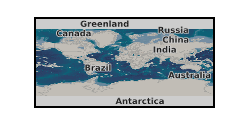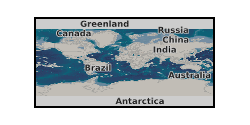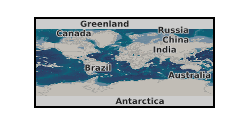University of Edinburgh
Type of resources
Topics
Keywords
Contact for the resource
Provided by
Years
Formats
Representation types
Update frequencies
Resolution
-

Technical report (2009) commissioned by Christian Aid and written by researchers from the University of Edinburgh and the University of Surrey. It aims to explore the prospects for carbon capture and storage (CCS) to play a significant role within global action to mitigate the risk of climate change, with a focus on India. Available for download at http://hdl.handle.net/1842/15679.
-

This dataset relates to the scientific journal article "A pilot-scale study of dynamic response scenarios for the flexible operation of post-combustion CO2 capture" (Tait et al. 2016), a study which was funded as part of the call 2 project "Towards more flexible generation with CCS". Pilot plant data from five dynamic scenarios for post-combustion capture on a state-of the-art NGCC plant (circa 2015) are included. The output from a novel solvent sensor, which can provide continuous online measurement of solvent CO2 loading is also included for several scenarios. The article can be found at: http://dx.doi.org/10.1016/j.ijggc.2015.12.009. More information on the project is available at https://ukccsrc.ac.uk/resources/ccs-projects-directory/towards-more-flexible-power-generation-ccs-pilot-plant-test
-

A selection of abstracts and posters presented at international conferences as part of EPSRC Grant #EP/K036033/1.
-

Contains 6 SCCS technical briefings, technical letters and technical journal responses - Working Paper 2010-04: Popular response to Economides, CO2 storage is feasible; Working Paper 2010-05: Formal response to Economides, CO2 storage is feasible; Working Paper 2010-07: Comment on Little and Jackson: Potential Impacts of Leakage from Deep CO2 Geosequestration on Overlying Freshwater Aquifers; Working Paper 2012-01: Comment by Stuart Haszeldine on Zoback and Gorelick; Working Paper 2014-01: Sleipner CO2 securely stored deep beneath seabed, in spite of unexpected Hugin fracture discovery; Working Paper 2015-02: Carbon Dioxide Transport Plans for Carbon Capture and Storage in the North Sea Region - A summary of existing studies and proposals applicable to the development of Projects of Common Interest.
-
This dataset contains data on temperature and tritrophic phenology collected across 44 sites in Scotland for the period 2014 – 2021. Each site was visited every two days through the spring. The phenology of first budburst and leaf out of approx. 700 marked trees was recorded. Every four days marked branches were beaten and data was collected on the number of caterpillars (and spiders and beetles). Data on the breeding phenology (first egg date, hatch date) and breeding success of blue tits was recorded at 4-8 nestboxes per site. This work was supported by Natural Environment Research Council grant NE/P011802/1. Full details about this dataset can be found at https://doi.org/10.5285/b63d53ae-2fe7-4ce9-82a2-2325098489e3
-

This collection comprises two time-series of 3D in-situ synchrotron x-ray microtomography (μCT) volumes showing two Ailsa Craig micro-granite samples (ACfresh02 and ACHT01) undergoing triaxial deformation. These data were collected in-situ at the PSICHE beamline at the SOLEIL synchrotron, Gif-sur-Yvette, France in December 2016 (standard proposal 20160434) and are fully explained in Cartwright-Taylor A., Main, I.G., Butler, I.B., Fusseis, F., Flynn M. and King, A. (in press), Catastrophic failure: how and when? Insights from 4D in-situ x-ray micro-tomography, J. Geophys. Res. Solid Earth. Together, these two time-series show the influence of heterogeneity on the micro-crack network evolution. Ailsa Craig micro-granite is known for being virtually crack-free. One sample (ACfresh02) remained as-received from the quarry until it was deformed, while the second (ACHT01) was slowly heated to 600 degC and then slowly cooled prior to deformation in order to introduce material disorder in the form of a network of nano-scale thermal cracks. Thus these two samples represent two extreme end-members: (i) ACfresh02 with the lowest possible (to our knowledge) natural pre-existing crack density, and so is a relatively homogeneous sample and (ii) ACHT01 with a thermally-induced nano-crack network imprinted over the nominally crack-free microstructure, and therefore has increased heterogeneity relative to ACfresh02. Each 3D μCT volume shows the sub-region of each sample in which the majority of damage was located and has three parts. Part one is reconstructed 16-bit greyscale data. Part two is 8-bit binary data showing individual voids (pores and micro-cracks) in the dataset after segmentation. Part three is 32-bit data showing the local thickness of each void, as in Cartwright-Taylor et al. (in press) Figures 4 and 5. Each part is a zip file containing a sequence of 2D image files (.tif), sequentially numbered according to the depth (in pixels, parallel to the loading axis) at which it lies within the sample volume. File dimensions are in pixels (2D), with an edge length of 2.7 microns. Each zip file is labelled with the sample name, the relevant letter for each 3D volume as given in Cartwright-Taylor et al. (in press) Tables 3 and 4, part 1, 2 or 3 (depending whether the data are greyscale, binary or local thickness respectively), the differential stress (MPa) on the sample, and the associated ram pressure (bar) to link with individual file names. The following convention is used: sample_letter_part_differentialstress_rampressure_datatype. Also included are (i) two spreadsheets (.xlsx), one for each sample, containing processing parameters and the mechanical stress and strain at which each volume was scanned, and (ii) zip files containing .csv files containing measurement data for the labelled voids in each volume. N.B. void label numbers are not consistent between volumes so they can only be used to obtain global statistics, not to track individual voids.
-
The resource contains experimental data collected at the Institute of Ecology and Evolution, University of Edinburgh between Jan-Oct 2023. Sixty (60) lines from the Drosophila Genetic Reference Panel (DGRP) were exposed to an orally acquired infection of the bacterial pathogen Pseudomonas aeruginosa. Six to ten replicate flies for each line (60) and sex (2) were exposed. Total number of activity events were measured for each fly individually using Drosophila Activity Monitor (DAM), measured at 1 min resolution until death. Mortality was recorded as the last detected movement in DAM. Pathogen shedding was measured for each individual fly as the number of viable P. aeruginosa colony-forming units defecated by an infected fly for 24h following oral infection. Full details about this nonGeographicDataset can be found at https://doi.org/10.5285/65c7085a-7bcf-481a-884a-8e1c9cfc395b
-
This dataset includes information on native eyebright plants (Euphrasia, Orobanchaceae) studied and measured at a range of sites across Britain and Ireland, with a special sampling focus on Fair Isle (Shetland, Scotland). Attributes measured are location information (Euphrasia species, coordinates and population description), individual plant trait data (including measures of floral and vegetative traits) and genome sizes. Full details about this dataset can be found at https://doi.org/10.5285/0a77d3b5-03ce-4a14-ab2d-acc4aa7bd0ef
-
This dataset contains geographic locations, including the horizontal and vertical position, of the perimeter of the Ciste Mhearad snow patch on Cairngorm for three dates in the summer of 2023. Points on the perimeter were located using two Global Navigation Satellite System (GNSS) receivers as base and roving stations during visits on 19 June, 27 July and 28 July 2023. Full details about this dataset can be found at https://doi.org/10.5285/81d05a77-4c95-4f17-bdbf-4c0a0095db6d
-

This is a blog (Update, 20.01.15) on the UKCCSRC Call 2 project, Quantifying Residual and Dissolution Trapping in the CO2CRC Otway Injection Site. Grant number: UKCCSRC-C2-204.
 NERC Data Catalogue Service
NERC Data Catalogue Service